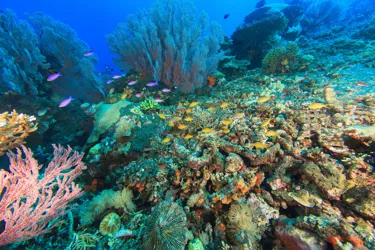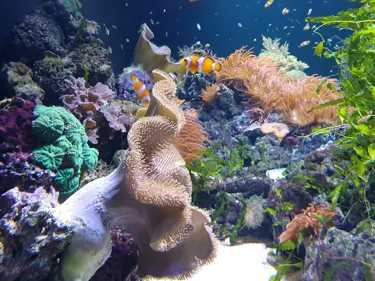Discover Coral Reef Ecosystems
- Wednesday 8th March 2023

An Introduction to Coral Reef Ecosystems
Coral reefs are one of the most beautiful and diverse ecosystems on the planet. Often called ‘the rain forests of the seas’, there are thousands of different species of coral all over the world. Some live in warm tropical waters, whilst others live in the coldest, darkest depths of the ocean. No matter where you find them, they all host a variety of different living organisms. In fact, up to 25 percent of all the fish in the sea depend on them for a healthy life. Contrary to popular belief, the corals (that make up the reef) are, in fact, alive. They are closely related to animals like jellyfish and sea anemones, which are collectively known as ‘Cnidarians’.
Scientists believe that they are one of the building blocks that make marine life possible (they have also been used as a source of food and medicine for humans across the globe). They used to be given as gifts in the form of jewellery and ornaments, until people realised the negative impact that was having on the environment. However, due to overfishing, pollution and climate change heating the planet’s oceans, coral reefs are disappearing at an alarming rate. When corals become sick and reefs become weakened, it is known as ‘coral bleaching’. Luckily, corals can recover from the bleaching, but the process takes many years.
If you’re interested in discovering more about these majestic ocean structures, read on to find out some fun facts about coral reefs.
- What is Coral Reef?
- What is a Coral Reef Ecosystem?
- What are Coral Reef Characteristics?
- Coral Reef Facts
- FAQs about Coral Reef Ecosystems
What is Coral Reef?
Coral reefs are underwater structures primarily built by corals. Corals are colonial organisms composed of hundreds, and sometimes thousands (or more), of individual animals called polyps. These colonies grow at a typical rate of 0.008 to 0.12 inches per year. Each individual polyp has a stomach and mouth surrounded by tentacles, which are used to clear away debris in the surrounding waters. These tentacles also contain little stingers (a bit like a jellyfish) that are used to hunt and capture smaller animals for food and defend themselves against predators (and occasionally each other).
The stony-looking reefs that many people think of when they imagine a coral reef are actually produced by a certain type of coral called ‘hard corals’. Characterised by their solid exoskeletons, they are the literal bedrock of the reef. The colony of polyps that make up hard corals are capable of drawing dissolved calcium from the surrounding seawater. They then solidify it into calcium carbonate, which then becomes their hard outer skeleton. The growth of the polyps’ skeletons is what builds up the reef structure over time. In fact, you can only find living corals on the thin top layer of the reef. Below them are the calcium carbonate skeletons. Corals have been on this planet for at least 400 million years, so many parts of the reef are older than you.
The polyps of these reef-building corals contain microscopic algae called ‘zooxanthellae’. The algae live with the polyps in a symbiotic relationship. The polyps give the algae a home and, in exchange, the algae provide the polyps with food (sugars) generated via photosynthesis. This is why reef-building corals tend to be found in clearer, shallower waters, as they need to live in places where the sunlight can reach them.
The World’s most famous and beautiful Coral Reefs
Some of the biggest and best-known reefs in the world include:
- The Great Barrier Reef in Australia. Known to be the largest coral reef on Earth, it comprises over 3,000 individual reef systems and 400 different types of coral. It is a UNESCO World Heritage Site and one of the Seven Natural Wonders of the World.
- The New Caledonia Barrier Reef in the Pacific Ocean. As the second-largest double barrier reef in the world, this UNESCO World Heritage Site is estimated to be home to 9,300 marine species and almost 500 species of coral (and even more have yet to be discovered).
- The Red Sea Coral Reef (Egypt, Jordan, Saudi Arabia). Located in the Indian Ocean between the scorching Sahara and Arabian deserts, the reef is around 1,200 miles long and over 5,000 years old. This reef is surprisingly resilient to the effects of rising ocean temperatures. However, it is not immune to overfishing or pollution from tourists.
- The Belize Barrier Reef. This coral reef, located in Belize, is the largest barrier reef in the northern hemisphere. The reef is comprised of 106 hard and soft coral species, and over 500 species of fish. It was declared a UNESCO World Heritage Site in 1996.
- The Apo Reef in the Philippines. Located in the South China Sea, it is the second longest continuous coral reef in the world. Encompassing 34 square kilometres, it is the biggest reef in the country and you can see it poking out onto the surface on certain islands in the area.

What is a Coral Reef Ecosystem?
A coral reef ecosystem refers to the range of organisms living in and around coral reefs. An ecosystem can be defined as a geographic area where plants (like seagrass), animals (like polyps and fish), other types of organism (such as algae) as well as the weather (or lack of) and the natural landscape, coexist together to form a system of life. All manner of marine life uses the coral reefs to find food and shelter, reproduce and raise their young. As a result, coral reef ecosystems around the world are teaming with life and their diversity is almost completely unrivalled by other natural habitats (they’re also very noisy if you happen to swim close to one). For example, the coral reefs that make up the Tubbataha Reefs in the Philippines are home to around 600 species of fish, 360 species of coral (both soft and hard), 11 species of sharks, 13 species of dolphins, and even some whales and sea turtles. That’s quite a community.
However, land-based pollutants, such as from deforestation (which produces sediments in the water supply), agricultural runoff (like fertilisers) and chemical spills (like oil), hinder the healthy growth of these thriving underwater ecosystems. The external toxins cause damage and spread disease in the coral reefs. This can lead to a sickness called coral bleaching, a process where the polyps expel the algae from the coral, which turns the reef completely white. The bleached corals are not dead and can survive a coral bleaching, but they are significantly weakened because they have lost a key source of food. This weakness leaves them susceptible to predators and other negative influences of the surrounding natural environment. In 2005, the USA lost around half of its coral reefs (near the Caribbean) in just one year due to coral bleaching. Scientists estimate that, between 2014 and 2017, coral bleaching (caused by unusually high temperatures in the ocean) affected 70 percent of coral reef ecosystems worldwide.
What are Coral Reef Characteristics?
The typical characteristics of a coral reef ecosystem depend on where in the world they are located. However, certain reef-building corals do share similar traits. In general, reef-building species of corals will contain polyps that have a hard exoskeleton. Reef-building corals found in shallow waters all have a symbiotic relationship with a photosynthetic algae called zooxanthellae, which allows them to have a constant source of food. The algae also help the corals to remove waste products from their colony. They prefer clear, warm, moving water in subtropical and tropical seas.
Reef-building corals found in deeper parts of the ocean do not have this relationship with zooxanthellae because the waters are colder and do not get enough sunlight (in some parts of the sea, they get none). Instead, all deep-sea corals take in plankton and organic matter in order to satisfy their needs. These corals live anywhere from 150 feet to more than 10,000 feet below sea level and do not form the rock-like reefs that you might have already seen. Instead, the cold-water corals form underwater forests filled with tree-like structures in the shapes of feathers and fans. Many different species of fish, crab and other aquatic creatures, including many not yet discovered, use these corals as their homes.
Quick Coral Reef Facts to Impress your Friends
Coral reefs are a fascinating and unique part of our planet’s oceans. So, now you know a thing or two about reef-building corals, let’s take a look at some interesting and unusual facts about coral reefs that you may not be too familiar with. Did you know:
- Coral reefs are regularly used in the development of human and animal medicines, including treatments for cancer and Alzheimer’s disease.
- Some corals contain fluorescent molecules, which means they glow in the dark (in a variety of different colours). Scientists think that these molecules may have a protective function against ultraviolet and high light.
- Corals are what’s known as ‘indicator’ species. This means that they are very sensitive to any environmental changes in their surroundings. Researchers wonder if, under perfect conditions, they might be able to live forever.
- When corals are babies, they can swim. In the larval stage of development, they can ride (or surf) ocean currents in order to find a suitable place to live. Once they are satisfied, they attach themselves to the new location and become a colony.
- Coral reefs are a vital part of coastal protection. The reefs help to form a barrier that breaks waves before the shoreline. This defends infrastructure and prevents loss of life during storms, tsunamis, floods and erosion.
- Corals are important for many countries’ tourism. Globally, coral reefs contribute billions of pounds to different economies.
We hope it’s clear now why coral reefs are so amazing and precious to us. They are not only important for marine life but for human life as well. They do an enormous amount for all animal ecosystems and need to be treated with respect and care. If we do our part now, we can preserve these natural wonders for generations to come.
FAQs about Coral Reef Ecosystems
What are coral reef characteristics?
Reef-building corals found in shallow waters have a symbiotic relationship with photosynthetic algae called zooxanthellae. This allows them to have a constant source of food. However, deep-sea reef-building corals take in plankton and other organic matter in order to gain nourishment.
What are the benefits of coral reef ecosystems?
There are a number of benefits to coral reef ecosystems, including coastal protection for infrastructure (by breaking waves before the shoreline), their use in the development of human medicines and as a lucrative source of tourism for adjacent countries.
What does coral do for the ecosystem?
Coral and the reefs they create are vital for both human and marine ecosystems. They provide a habitat that feeds and raises over 1 million different aquatic species. Around half a billion people globally depend on coral reefs for food, protection and income.
Online from
£31
Per adult
On the day
£39
Per adult
Animal Crossing Event Ends 27 July
- Entry at your chosen 15-minute time slot
- Discover species from around the world in 14 themed zones and interact with them at our public feeding, diving displays and touch pools
- Animal Crossing: New Horizons event is included with all SEA LIFE London entry tickets - just book any day from 30 June - 27 July
Online from
£36
Per adult
On the day
£44
Per adult
- Enjoy the freedom to arrive at any time on the day of your choice - no rush, just adventure at your own pace!
- Animal Crossing: New Horizons event is included with all SEA LIFE London entry tickets - just book any day from 30 June - 27 July